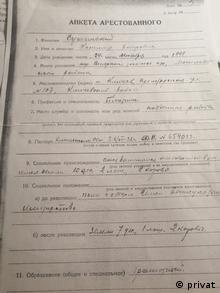
The association of former security forces BYPOL is working on the KGB’s database of repressed Soviet-era Belarusians to “make it available to everyone who wants information about their relatives”. DW was informed about this by the head of BYPOL and a representative of the cabinet of democratic forces Alexander Azarov. In Belarus, the KGB archives have never been opened, access to the archives, and even then very limited, is available only to relatives of victims of Stalinist repression.
Relatives cannot access the file directly
Questionnaire for the detainee, copy of the protocol with the verdict, extract from the execution protocol, letter from the KGB from the Mogilev region, in which a whole human life fits in a few paragraphs: arrested, convicted, the sentence was served. That’s all relatives know about the fate of Kazimir Sushinsky, who was shot in Bobruisk in January 1938.
Photo of the document provided by the KGB for the Mogilev region
“Even in those few pages that we still managed to obtain over several years of correspondence, all the names of the participants were sealed, we were not provided with an interrogation protocol and depositions. It was important for us not to get copies, answers, but to touch the papers signed by our ancestor, perhaps, to feel what he felt at that moment, to somehow survive”, says one of the descendants of the repressed Kazimir Sushinsky. The man agreed to speak with DW on condition of anonymity. fears persecution by security forces in modern Belarus.
Kazimir Sushinsky, a 38-year-old carpenter from the artel “Association” of the Mogilev Forestry and Chemical Union, was arrested by the Klichevsky regional department of the NKVD on November 16, 1937. Less than two weeks later, he was sentenced to death and, on January 13, 1938, the sentence was carried out. Sushinsky is survived by a wife and three children – nine- and seven-year-old daughters and a two-year-old son.
Stuck on a neighbor’s complaint
“I often try to put myself in Casimir’s shoes: what did he have to endure during these two incomplete months, during which the so-called investigation took place, the court was convicted? He was accused of spying, probably for Poland, since Casimir was an ethnic Pole, counter-revolutionary propaganda and agitation, as well as membership in a counter-revolutionary organization (Articles 68, 72 and 76 of the BSSR Penal Code). the late 1930s, when the state encouraged whistleblowing in every way possible. Compare this with modern informants on “the whistleblower map,” notes the DW interlocutor.

Photo of the questionnaire provided by the KGB for the Mogilev region
Kazimir is not the only victim of the Red Terror in the Sushinsky family – in 1919, the Bolsheviks shot his father Peter. “Three knights arrived, the insignia was not visible, in Polish they asked Pedro for water, he replied in Polish that there was even milk for the knights. – shares a descendant of Sushinsky. According to him, in this way, the family was not only without support, but also without defenders during the Second World War: “It is a miracle that Casimir’s wife, alone with three children, survived the end of the 1930s, the the post-war starvation, with her being labeled “the wife of an enemy of the people”, it was impossible to get a job.
Unknown burial place
Kazimir Sushinsky was posthumously rehabilitated on November 27, 1958. Subsequently, his relatives received compensation for confiscated property and livestock. However, in his family, even after many years, it was not customary to talk about repressions, the older generation was simply afraid. “In the mid-1990s, one of Kazimir’s daughters received a letter from the KGB, which said her father had been rehabilitated, after reading it, she just cried softly,” recalls a descendant of the repressed. that after the war, when the lost documents were restored, “the names of the youngest children were changed, the son Vladislav was registered as Vladimir. And the daughter, apparently baptized Francesca, was called Franya all her life, this name migrated to all the documents and it’s even written on his headstone.”
The family does not know where Kazimir Sushinsky is buried, the KGB replied that there is no information about the specific burial place in the case file, it is not possible to establish it. “We would very much like to know the burial site to visit it at least sometimes. They wrote that approximately the area of the Bobruisk fortress. I hope that someday the remains will be found, I am ready to give a sample of my DNA to look for Kazimir Sushinsky,” says the source.
In the KGB archives in the Mogilev region, Kazimir Sushinsky’s relatives were informed that they would not have direct access to their ancestor’s criminal case, because there are names of scammers, investigators, those who approved and carried out the sentence, and allegedly the descendants of the victim of repression may begin to take revenge on them. “It’s a completely stupid idea not to give information to relatives, hiding behind the fear of revenge from descendants to descendants. I think someone just doesn’t want publicity. The fact that the files have not yet been opened means that the victims’ story is not over, that the lessons of the past state have not yet been learned”, summarizes a descendant of the executed Kazimir Sushinsky.
Source: DW
Anna White is a journalist at 247 News Reel, where she writes on world news and current events. She is known for her insightful analysis and compelling storytelling. Anna’s articles have been widely read and shared, earning her a reputation as a talented and respected journalist. She delivers in-depth and accurate understanding of the world’s most pressing issues.